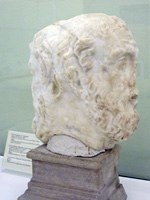

Stele of Bovara (late 3rd century BC)

------- / [---] Atiete en/ [-]laga dedre
The word Atiete is recognisable and known from the Ikuvine Tablets: it means a college of priests.
The location in which the inscription was found is only about 5 km from Picciche and about 10 km from Castel Ritaldi, the places in which the cippi inscribed with the Lex Spoletina were found. All three were inscribed in archaic Latin, and it seems likely that all three were associated with the nearby Roman colony at Spoletium. These inscriptions are described on the page Latin Inscriptions after 295 BC.
Inscription (late 1st century BC)

Base of a Statue (ca. 100 AD)

L(ucio) Succonio L(uci) f(ilio) Pal(atina)
Prisco IIII vir(o) i(ure) d(icundo) q(uaestori) a(erarii)
omnium corpor(um) patr(ono)
item Treb(i)is decur(ioni) pont(ifici)
IIIIvir(o) i(ure) d(icundo) patron(o) mun(icipii)
decuriae IIII scabillar(iorum)
veteres a scaena / amantissimo sui
ex aere conlato h(onore) a(ccepto) i(mpensam) r(emisit)
It commemorates Lucius Succonius Priscus, son of Lucius, who had held a number on important public offices in Trevi, including quattuorviro i(ure) d(icundo). He had also been the patron of all the corporations of Trevi and of the municipium itself. (This is the only surviving inscription that names the municipium)
The inscription also records that the statue had been erected by the "scabillares": these were musicians who accompanied themselves on the scabillium, a pair of hinged wooden plates attached to their sandals that they used to beat time, and they belonged to one of the corporations that Lucius Succonius had protected. The “scaena” was probably the theatre mentioned by Suetonius: "On another occasion, when [the Emperor Tiberius] recommended that the people of Trebia be allowed to use, in making a road, a sum of money which had been left them for the construction of a new theatre, he could not prevent the wish of the testator from being carried out" (De Vita Caesarum: Tiberius, paragraph 31). No trace of this theatre survives.
There is a second inscription commemorating Lucius Succonius Priscus in the Museo Archeologico, Spoleto.
Busts (2nd century AD)


"Janus" "Agripina"
These two marble busts came from the collection of Benedetto Valenti and, from the 16th century, adorned the entrance arch in front of Palazzo Valenti (see the Walk around Trevi).
-
✴"Janus" seems to be a composite Roman copy of two Greek portrait busts (ca. 480 BC) of Euripedes and Eschinus that are now in the Museo Capitolino, Rome.
-
✴"Agrippina" seems to be a Roman copy of the face of a Greek figure (ca. 440 BC) known as the wounded Niobid that is now in the Museo Nazionale Romano, Rome.
Inscription (3rd century AD)

C(AIUS?) LICINI[AN]VS (?)
CN(AEI) VESENTRONIS
URBANI (SERVUS) MEDICVS
CHIRURGVS
V(IXIT) A(NNIS) XXI
This is one of only two Latin inscriptions found within the walls of Trevi: the other is embedded in the portal of Sant' Emiliano.
Funerary inscription (probably 514 AD)

Grave goods from Pietrarossa (6th and 7th centuries AD)

There are interesting illustrations in this page in the website of Protagonista Slow.
Plaster casts from San Francesco


These plaster casts were made in the 19th century from the sculpted tympanum and reliefs of a king or emperor and a pope on the original facade of San Francesco. The inscription along the lower end of the tympanum records that Master Angelo built the church (or at least its facade) in 1268:
MAG(iste)R ANGELO FECIT HOC OP(us)
AN(n)O D(omi)NI MCCLXVIII M(en)SE MAII
AVE MARIA GRA(tia plena) DOMIN(us) TECU(m) B(e)N(e)D(i)CTA TU
Return to Museums of Trevi.

